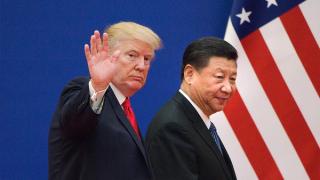Common wisdom was that Chinese President Xi Jinping’s ruthlessness, guile and patience would allow him to run rings around Donald Trump.
This is not how it is turning out, according to Vice-President Mike Pence, who raised eyebrows in a speech earlier this month, claiming China “wants a different American President”.
This might not be the case for all matters, but it applies with respect to the escalating trade war between the world’s two largest economies.
Assured by his advisers that US democracy was too divided and weak to tolerate economic disruption, Xi thought Trump would fold shortly after the economic war began. He has not.
Xi didn’t think Trump really wanted a substantive trade war or would resort to tariffs, but he did and has. Assured by his advisers that US democracy was too divided and weak to tolerate economic disruption, Xi thought Trump would fold shortly after the economic war began. He has not.
Trump’s America holds the stronger hand and is appearing more resolute, whereas behind the feigned confidence China is the more desperate for a deal to make it all stop.
The important question is whether Trump will choose to advance the noble objective of achieving free, fair and reciprocal trade — or simply punish China for no higher gain.
If China is the true target of Trump’s railing against the economic status quo as Pence suggested, then the president has got the sequencing right.
In the past few months, Trump has agreed to a deal with Canada and Mexico to revise NAFTA, agreed terms with South Korea, begun renegotiating with Japan, and made progress for an eventual trade deal with the European Union.
In addition to allowing the administration to focus primarily on China, the US and EU have even expressed common ground when it comes to reforming the global trade system and checking Chinese mercantilism and other breaches.
Currently, the US has levied 10 per cent on about $280 billion worth of Chinese imports, with the rate set to increase to 25 per cent by the year’s end. It is unlikely to stop there.
Xi fears an escalating trade war because the direct consequences of a worsening dispute exacerbates China’s already severe imbalances.
Modelling based on there being a 20 per cent tariff placed on all imports and exports between the US and China suggests that the cost to these economies will be 0.25 per cent and 0.5 per cent of GDP respectively.
This appears insignificant, especially when China’s economy is growing at over 6 per cent. But there is much more going on beneath the surface. Xi fears an escalating trade war because the direct consequences of a worsening dispute exacerbates China’s already severe imbalances.
About half of all Chinese goods exported to the US face punitive measures. With the prospect of higher tariffs imposed on more Chinese goods to come, the trade war will lead to a significant contraction in China’s current account surplus with the US which was more than $US365bn in the first seven months of 2018.
The Chinese export sector employs tens of millions of workers on good wages. With much of this sector operating on wafer-thin margins, unemployment will rise significantly, and the corollary is that national savings will decline significantly.
Indeed, Beijing was eager to avoid rising unemployment in this sector for political reasons and lowered the reserve ratio requirement by 1 per cent earlier this month to stimulate investment. Yet all this achieves is to worsen the country’s already well documented excess capacity and debt problems at a time when its competitiveness in the US market, which absorbs around one-fifth of China’s exports, is declining due to Trump’s tariffs.
The option to devalue the renminbi to restore export competitiveness is also too risky.
Doing so would redouble Trump’s resolve to fight long and ugly in the trade-war and might cause other regional export-orientated economies to adopt similar measures.
The greater danger is that expectations of a declining renminbi would trigger massive capital flight out of China. In 2015, due to dangerous volumes of capital exiting the country following loss of confidence in the renminbi, Beijing was forced to sell more than $US1.4 trillion of its foreign exchange reserves to defend the value of its currency.
It is difficult to argue against Trump’s insistence on free, fair and reciprocal trade. But he has still to convince the rest of the world this is what he truly wants.
In contrast, the US seems in a better place to weather a trade war, at least in the short term, even if US consumers must pay more for Chinese imports and there would be supply disruptions. Even Chinese targeting of supposedly sensitive sectors such as soybeans have been blunted. EU soybean imports from the US have quadrupled from a year ago and China is stuck with buying more expensive Brazilian soybeans.
Will America’s structural and tactical advantages bear fruit? The problem remains lack of clarity with respect to objectives. The administration has pointed to different priorities, some of which are complementary: going after Chinese intellectual property violators, greater access for US firms in China, discouraging distorting subsidies to state-owned enterprises and national champions, and challenging Chinese plans to dominate industries as laid out in “Made in China 2025”.
Then there is the President’s favourite rationale which is to reduce the current account deficit. This is an irrelevant obsession which could not serve as the basis upon which other “friendly” economies such as the EU, Japan and Australia would support the US in any economic escalation.
The US needs allies in this fight. It is difficult to argue against Trump’s insistence on free, fair and reciprocal trade. But he has still to convince the rest of the world this is what he truly wants.






